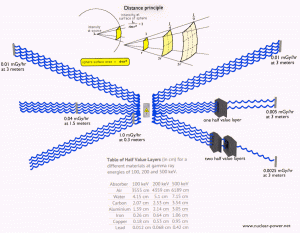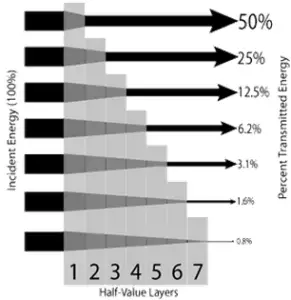One of radiation protection principles is optimisation of protection, which requires, that:
“doses should all be kept as low as reasonably achievable”.

This statement is known as the ALARA principle. ALARA is an acronym for “as low as is reasonably achievable”. The ALARA principle means that we should make all reasonable efforts to maintain exposures to radiation as far below the dose limits in this part as is practical consistent with the purpose for which the licensed activity is undertaken, while at the same time not wasting a lot of money, time and effort to do so. The ALARA principle arises from the fact that infinite time, effort and money could be spent in the attempt of reducing a risk to zero.
If the source of radiation is too intensive and time or distance do not provide sufficient radiation protection, the shielding must be used. Radiation shielding usually consist of barriers of lead, concrete or water. There are many many materials, which can be used for radiation shielding, but there are also many situations in radiation protection. It highly depends on the type of radiation to be shielded, its energy, and many other parametres.
Generally, shielding of gamma rays is based on attenuation theory, which uses the concept of half-value layers. The half value layer expresses the thickness of absorbing material needed for reduction of the incident radiation intensity by a factor of two. As a result, according to attenuation theory, it is impossible to shield radiation completely, because attenuation is exponential. Almost every time some radiation, however small, travels through radiation shield.
 Recall, today the protection system is based on the LNT-hypothesis, assuming that all radiation is bad and that the deleterious effect (essentially the cancer risk) increases linearly with dose with no threshold (start at zero dose). But we cannot shield radiation completely, becauses it would require radiation shields of infinite thickness. So what is the optimal thickness of radiation shield? Since zero dose is not attainable, we can only minimize effects of radiation As Low As is Reasonable Achievable (the ALARA – principle). The ALARA principle is also reflected in dose limits. In general, these limits are set to limit stochastic effects to an acceptable level, and to prevent deterministic effects completely.
Recall, today the protection system is based on the LNT-hypothesis, assuming that all radiation is bad and that the deleterious effect (essentially the cancer risk) increases linearly with dose with no threshold (start at zero dose). But we cannot shield radiation completely, becauses it would require radiation shields of infinite thickness. So what is the optimal thickness of radiation shield? Since zero dose is not attainable, we can only minimize effects of radiation As Low As is Reasonable Achievable (the ALARA – principle). The ALARA principle is also reflected in dose limits. In general, these limits are set to limit stochastic effects to an acceptable level, and to prevent deterministic effects completely.
We hope, this article, ALARA and Radiation Shielding, helps you. If so, give us a like in the sidebar. Main purpose of this website is to help the public to learn some interesting and important information about radiation and dosimeters.